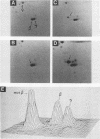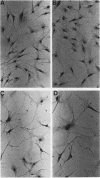Abstract
Two different mutant human beta-actin genes have been introduced into normal diploid human (KD) fibroblasts and their immortalized derivative cell line, HuT-12, to assess the impact of an abnormal cytoskeletal protein on cellular phenotypes such as morphology, growth characteristics, and properties relating to the neoplastic phenotype. A mutant beta-actin containing a single mutation (Gly-244----Asp-244) was stable and was incorporated into cytoskeletal stress fibers. Transfected KD cells which expressed the stable mutant beta-actin in excess of normal beta-actin were morphologically altered. In contrast, a second mutant beta-actin gene containing two additional mutations (Gly-36----Glu-36 and Glu-83----Asp-83, as well as Gly-244----Asp-244) did not alter cell morphology when expressed at high levels in transfected cells, but the protein was labile and did not accumulate in stress fibers. In both KD and HuT-12 cells, endogenous beta- and gamma-actin decreased in response to high-level expression of the stable mutant beta-actin, in a manner consistent with autoregulatory feedback of actin concentrations. Since the percent decreases in the endogenous beta- and gamma-actins were equal, the ratio of net beta-actin (mutant plus normal) to gamma-actin was significantly increased in the transfected cells. Antisera capable of distinguishing the mutant from the normal epitope revealed that the mutant beta-actin accumulated in stress fibers but did not participate in the formation of the actin filament-rich perinuclear network. These observations suggest that different intracellular locations differentially incorporate actin into cytoskeletal microfilaments. The dramatic impact on cell morphology and on beta-actin/gamma-actin ratios in the transfected diploid KD cells may be related to the acquisition of some of the characteristics of cells that underwent the neoplastic transformation event that originally led to the appearance of the beta-actin mutations.
Full text
PDF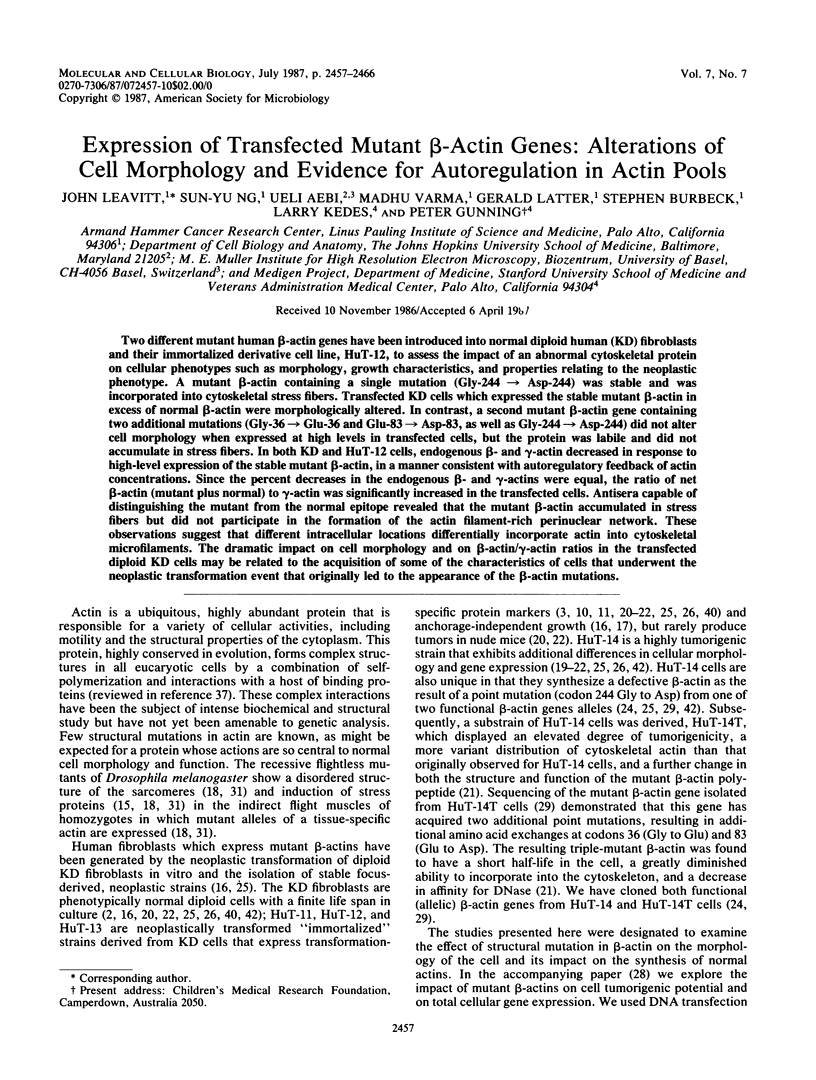
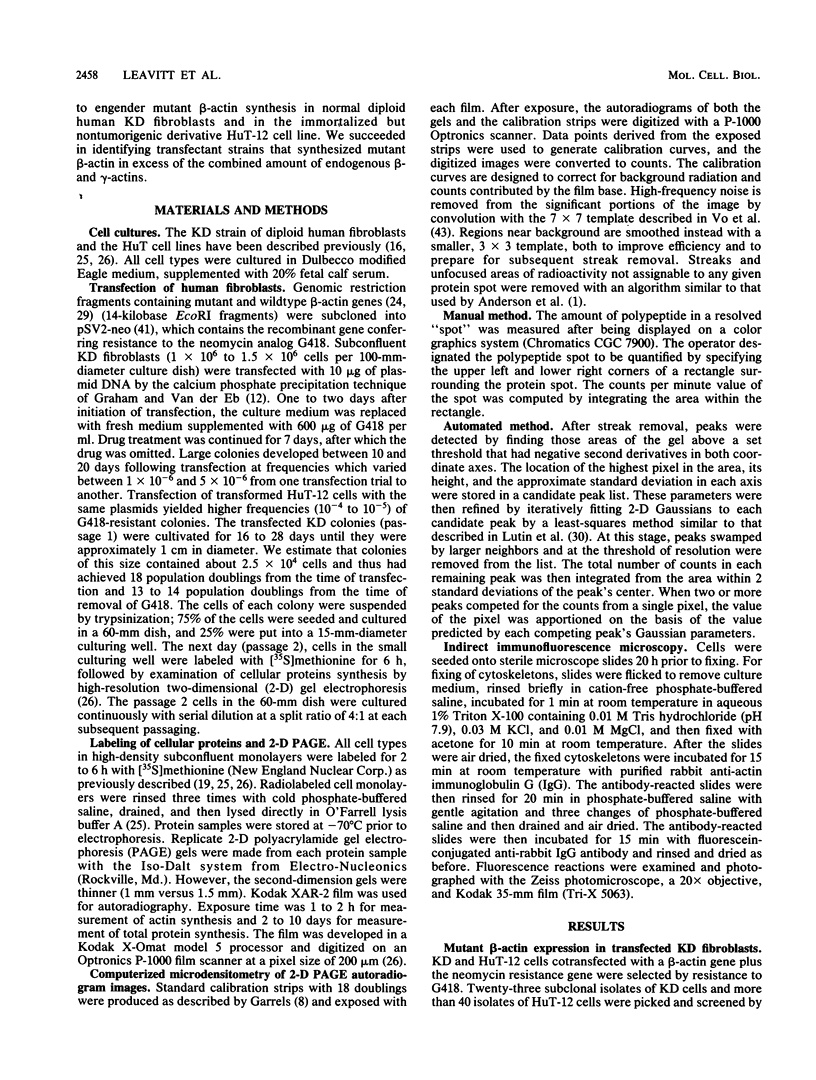
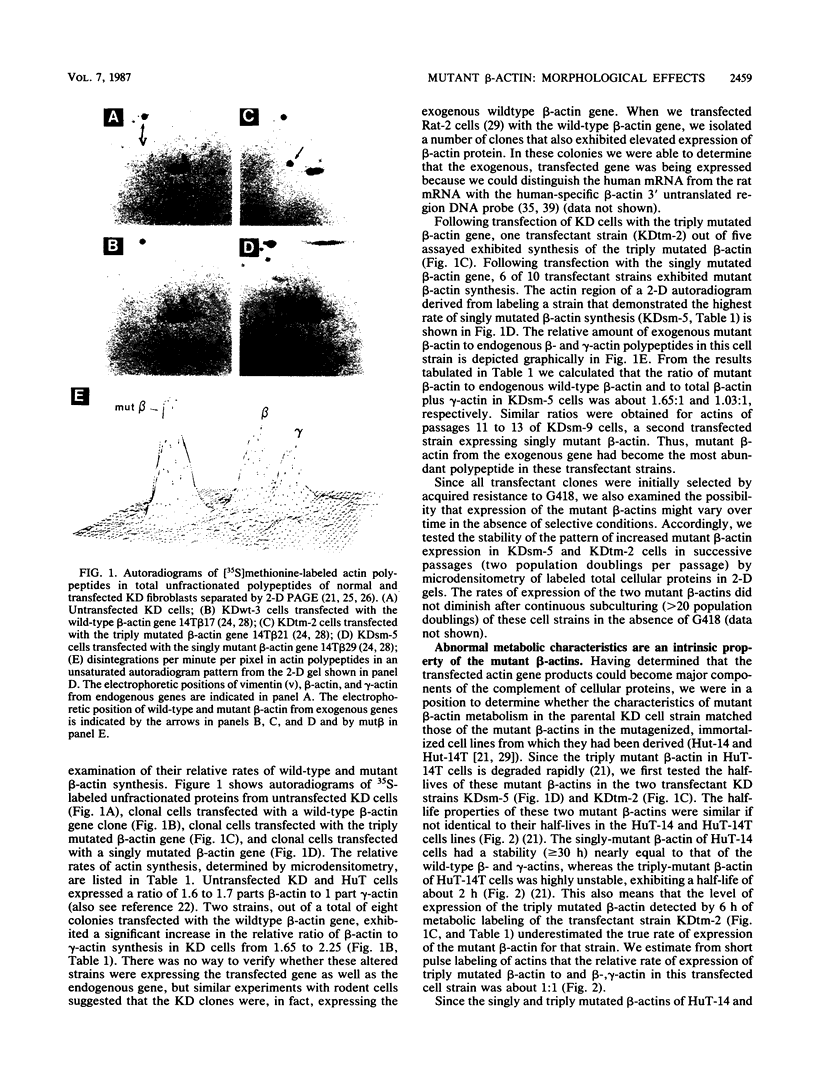
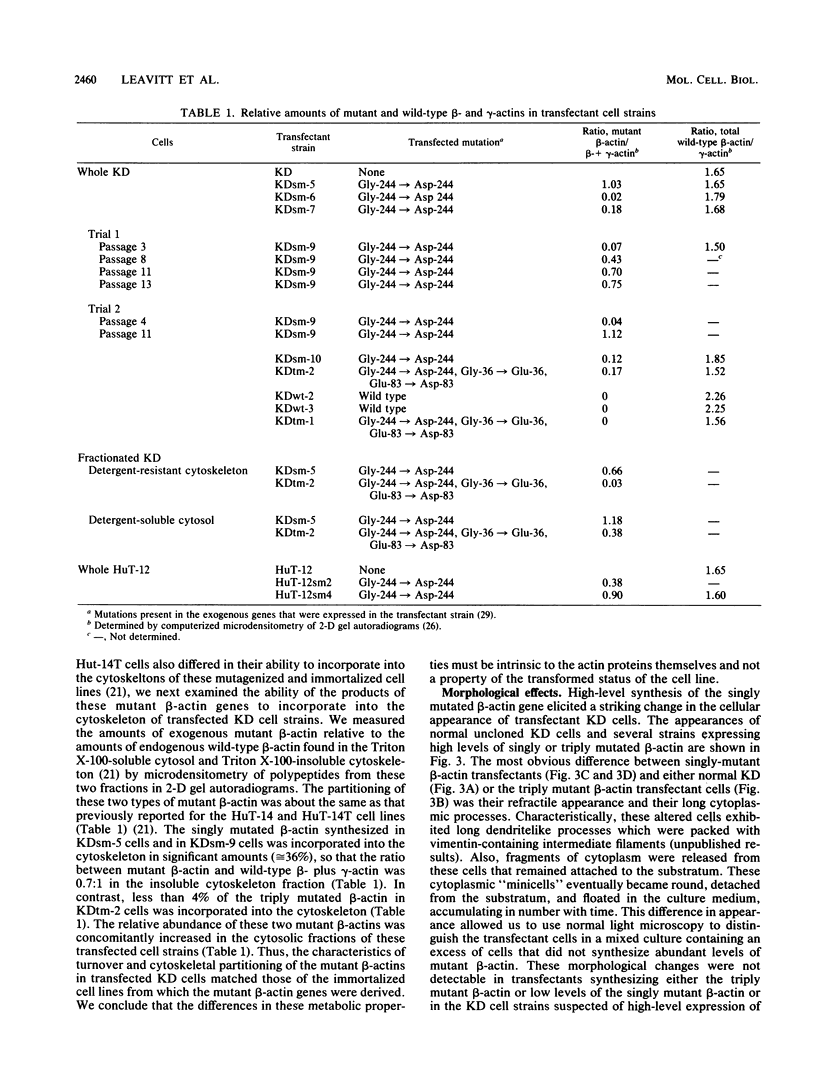
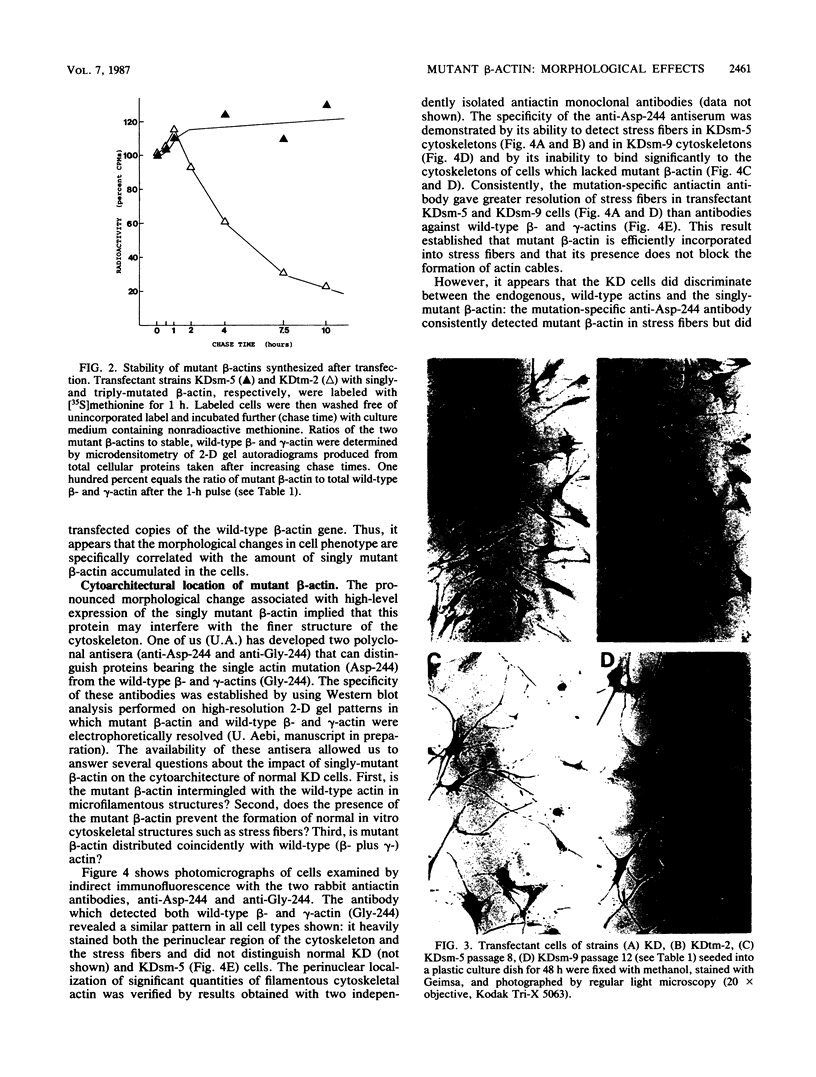
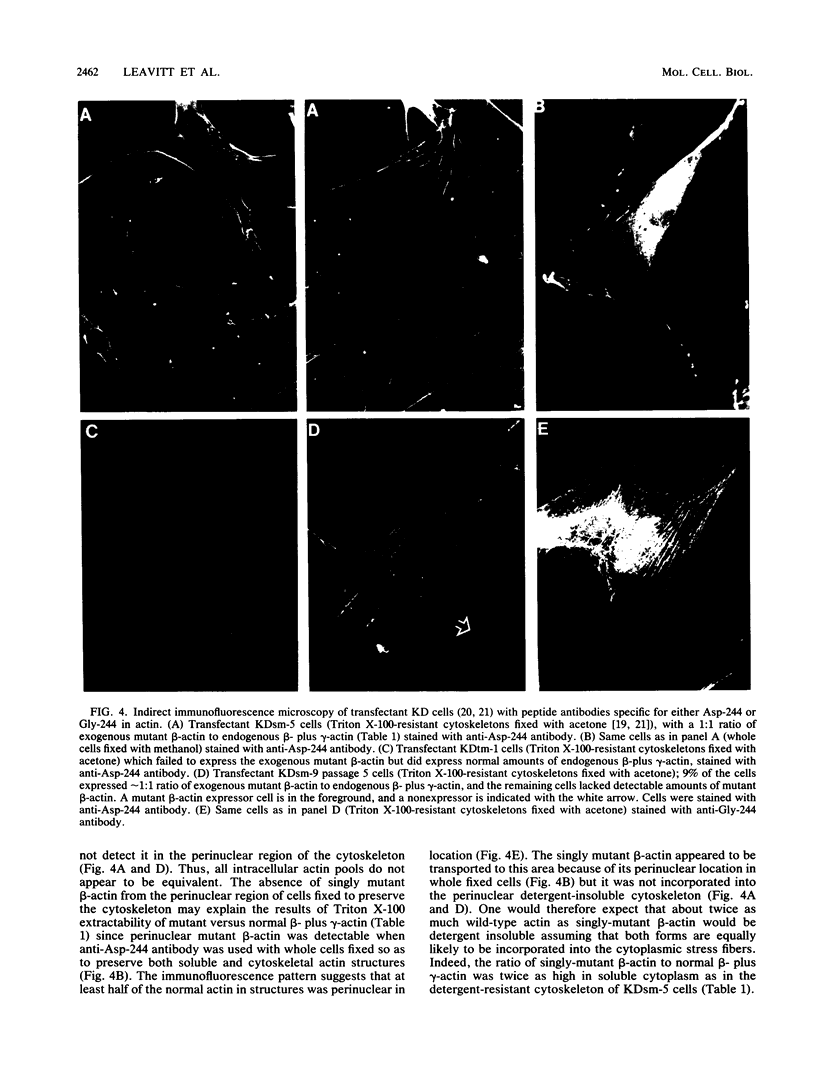
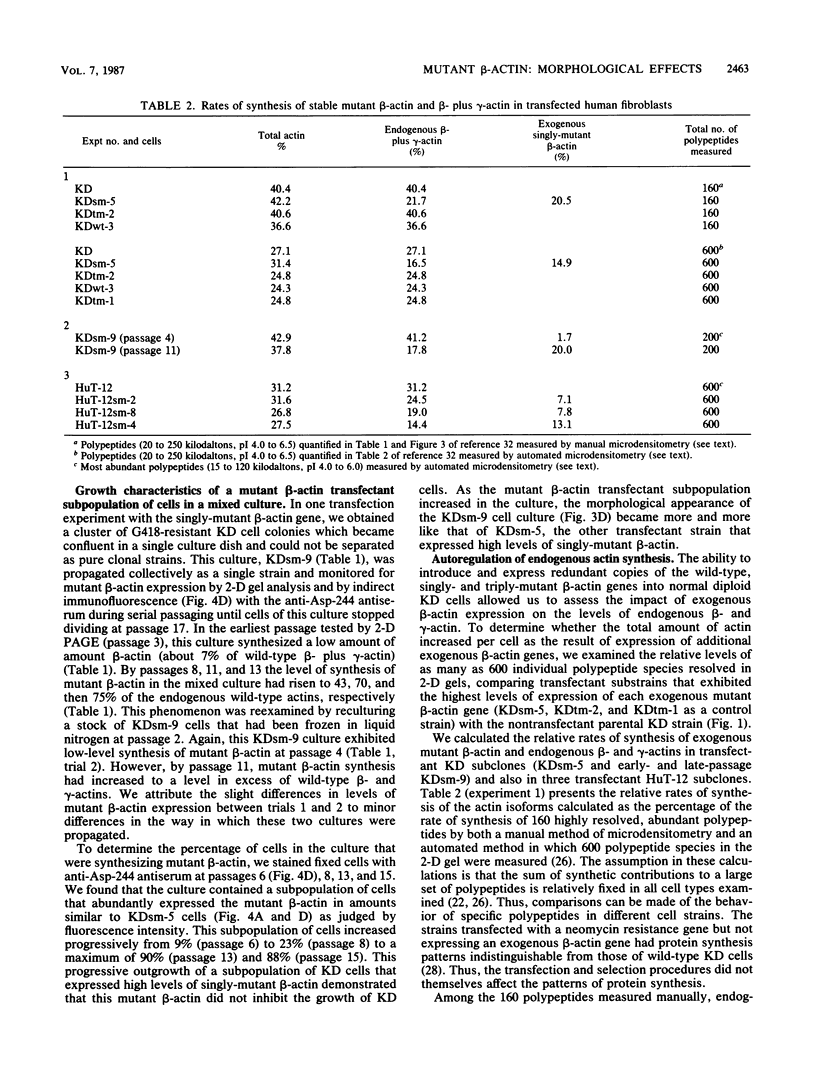
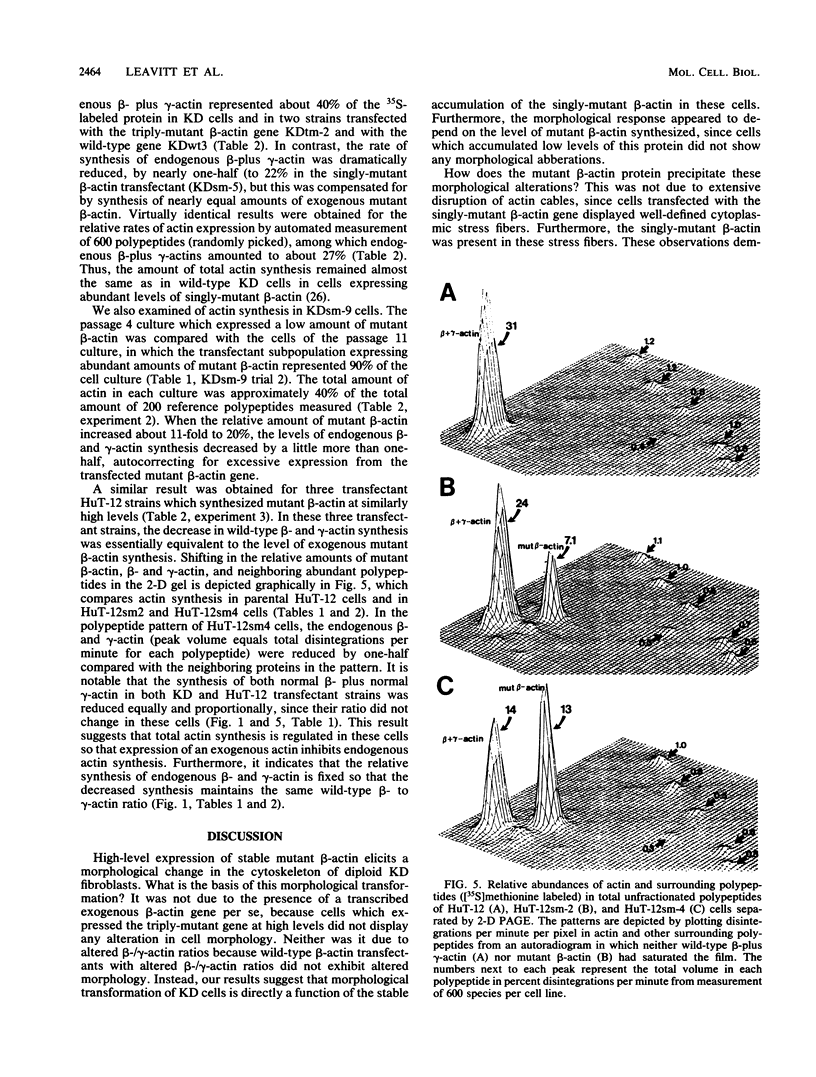
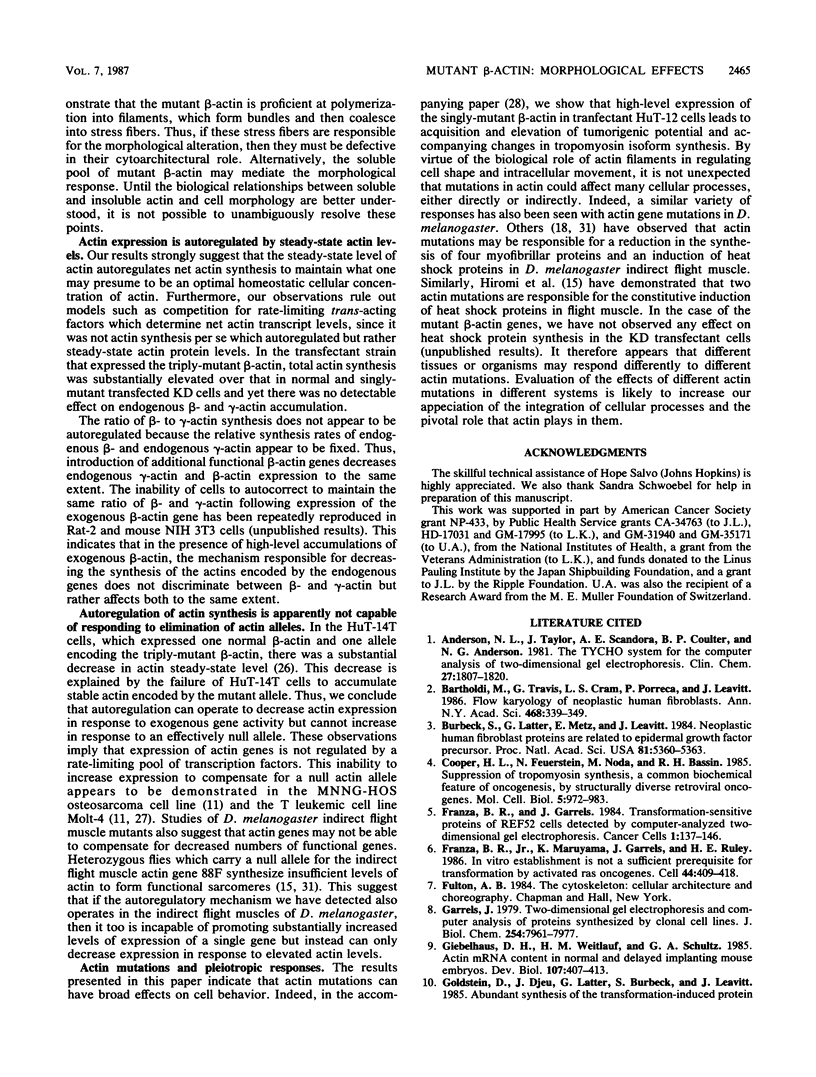
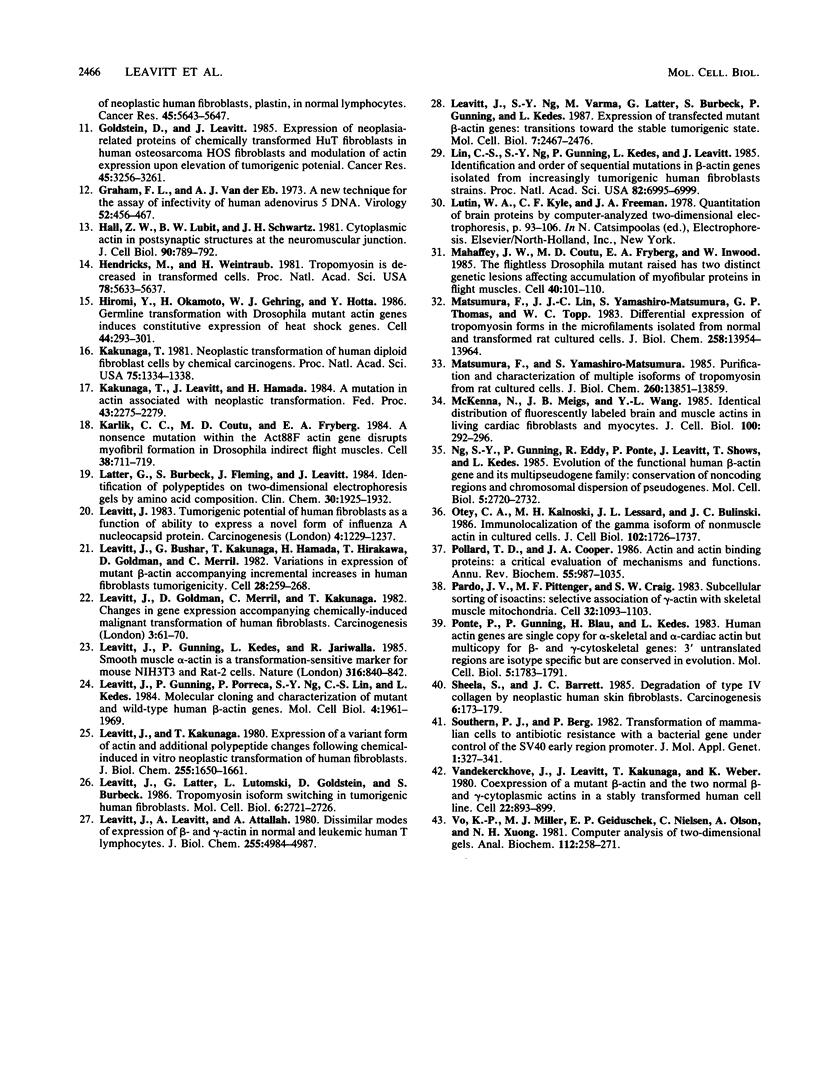
Images in this article
Selected References
These references are in PubMed. This may not be the complete list of references from this article.
- Anderson N. L., Taylor J., Scandora A. E., Coulter B. P., Anderson N. G. The TYCHO system for computer analysis of two-dimensional gel electrophoresis patterns. Clin Chem. 1981 Nov;27(11):1807–1820. [PubMed] [Google Scholar]
- Bartholdi M., Travis G., Cram L. S., Porreca P., Leavitt J. Flow karyology of neoplastic human fibroblasts. Ann N Y Acad Sci. 1986;468:339–349. doi: 10.1111/j.1749-6632.1986.tb42051.x. [DOI] [PubMed] [Google Scholar]
- Burbeck S., Latter G., Metz E., Leavitt J. Neoplastic human fibroblast proteins are related to epidermal growth factor precursor. Proc Natl Acad Sci U S A. 1984 Sep;81(17):5360–5363. doi: 10.1073/pnas.81.17.5360. [DOI] [PMC free article] [PubMed] [Google Scholar]
- Cooper H. L., Feuerstein N., Noda M., Bassin R. H. Suppression of tropomyosin synthesis, a common biochemical feature of oncogenesis by structurally diverse retroviral oncogenes. Mol Cell Biol. 1985 May;5(5):972–983. doi: 10.1128/mcb.5.5.972. [DOI] [PMC free article] [PubMed] [Google Scholar]
- Franza B. R., Jr, Maruyama K., Garrels J. I., Ruley H. E. In vitro establishment is not a sufficient prerequisite for transformation by activated ras oncogenes. Cell. 1986 Feb 14;44(3):409–418. doi: 10.1016/0092-8674(86)90462-9. [DOI] [PubMed] [Google Scholar]
- Garrels J. I. Two dimensional gel electrophoresis and computer analysis of proteins synthesized by clonal cell lines. J Biol Chem. 1979 Aug 25;254(16):7961–7977. [PubMed] [Google Scholar]
- Giebelhaus D. H., Weitlauf H. M., Schultz G. A. Actin mRNA content in normal and delayed implanting mouse embryos. Dev Biol. 1985 Feb;107(2):407–413. doi: 10.1016/0012-1606(85)90322-7. [DOI] [PubMed] [Google Scholar]
- Goldstein D., Leavitt J. Expression of neoplasia-related proteins of chemically transformed HuT fibroblasts in human osteosarcoma HOS fibroblasts and modulation of actin expression upon elevation of tumorigenic potential. Cancer Res. 1985 Jul;45(7):3256–3261. [PubMed] [Google Scholar]
- Graham F. L., van der Eb A. J. A new technique for the assay of infectivity of human adenovirus 5 DNA. Virology. 1973 Apr;52(2):456–467. doi: 10.1016/0042-6822(73)90341-3. [DOI] [PubMed] [Google Scholar]
- Hall Z. W., Lubit B. W., Schwartz J. H. Cytoplasmic actin in postsynaptic structures at the neuromuscular junction. J Cell Biol. 1981 Sep;90(3):789–792. doi: 10.1083/jcb.90.3.789. [DOI] [PMC free article] [PubMed] [Google Scholar]
- Hendricks M., Weintraub H. Tropomyosin is decreased in transformed cells. Proc Natl Acad Sci U S A. 1981 Sep;78(9):5633–5637. doi: 10.1073/pnas.78.9.5633. [DOI] [PMC free article] [PubMed] [Google Scholar]
- Hiromi Y., Okamoto H., Gehring W. J., Hotta Y. Germline transformation with Drosophila mutant actin genes induces constitutive expression of heat shock genes. Cell. 1986 Jan 31;44(2):293–301. doi: 10.1016/0092-8674(86)90763-4. [DOI] [PubMed] [Google Scholar]
- Kakunaga T., Leavitt J., Hamada H. A mutation in actin associated with neoplastic transformation. Fed Proc. 1984 May 15;43(8):2275–2279. [PubMed] [Google Scholar]
- Kakunaga T. Neoplastic transformation of human diploid fibroblast cells by chemical carcinogens. Proc Natl Acad Sci U S A. 1978 Mar;75(3):1334–1338. doi: 10.1073/pnas.75.3.1334. [DOI] [PMC free article] [PubMed] [Google Scholar]
- Karlik C. C., Coutu M. D., Fyrberg E. A. A nonsense mutation within the act88F actin gene disrupts myofibril formation in Drosophila indirect flight muscles. Cell. 1984 Oct;38(3):711–719. doi: 10.1016/0092-8674(84)90266-6. [DOI] [PubMed] [Google Scholar]
- Latter G. I., Burbeck S., Fleming J., Leavitt J. Identification of polypeptides on two-dimensional electrophoresis gels by amino acid composition. Clin Chem. 1984 Dec;30(12 Pt 1):1925–1932. [PubMed] [Google Scholar]
- Leavitt J., Bushar G., Kakunaga T., Hamada H., Hirakawa T., Goldman D., Merril C. Variations in expression of mutant beta actin accompanying incremental increases in human fibroblast tumorigenicity. Cell. 1982 Feb;28(2):259–268. doi: 10.1016/0092-8674(82)90344-0. [DOI] [PubMed] [Google Scholar]
- Leavitt J., Goldman D., Merril C., Kakunaga T. Changes in gene expression accompanying chemically-induced malignant transformation of human fibroblasts. Carcinogenesis. 1982;3(1):61–70. doi: 10.1093/carcin/3.1.61. [DOI] [PubMed] [Google Scholar]
- Leavitt J., Gunning P., Kedes L., Jariwalla R. Smooth muscle alpha-action is a transformation-sensitive marker for mouse NIH 3T3 and Rat-2 cells. 1985 Aug 29-Sep 4Nature. 316(6031):840–842. doi: 10.1038/316840a0. [DOI] [PubMed] [Google Scholar]
- Leavitt J., Gunning P., Porreca P., Ng S. Y., Lin C. S., Kedes L. Molecular cloning and characterization of mutant and wild-type human beta-actin genes. Mol Cell Biol. 1984 Oct;4(10):1961–1969. doi: 10.1128/mcb.4.10.1961. [DOI] [PMC free article] [PubMed] [Google Scholar]
- Leavitt J., Kakunaga T. Expression of a variant form of actin and additional polypeptide changes following chemical-induced in vitro neoplastic transformation of human fibroblasts. J Biol Chem. 1980 Feb 25;255(4):1650–1661. [PubMed] [Google Scholar]
- Leavitt J., Latter G., Lutomski L., Goldstein D., Burbeck S. Tropomyosin isoform switching in tumorigenic human fibroblasts. Mol Cell Biol. 1986 Jul;6(7):2721–2726. doi: 10.1128/mcb.6.7.2721. [DOI] [PMC free article] [PubMed] [Google Scholar]
- Leavitt J., Leavitt A., Attallah A. M. Dissimilar modes of expression of beta- and gamma-actin in normal and leukemic human T lymphocytes. J Biol Chem. 1980 Jun 10;255(11):4984–4987. [PubMed] [Google Scholar]
- Leavitt J., Ng S. Y., Varma M., Latter G., Burbeck S., Gunning P., Kedes L. Expression of transfected mutant beta-actin genes: transitions toward the stable tumorigenic state. Mol Cell Biol. 1987 Jul;7(7):2467–2476. doi: 10.1128/mcb.7.7.2467. [DOI] [PMC free article] [PubMed] [Google Scholar]
- Leavitt J. Tumorigenic potential of human fibroblasts as a function of ability to express a novel form of influenza A nucleocapsid protein. Carcinogenesis. 1983 Oct;4(10):1229–1237. doi: 10.1093/carcin/4.10.1229. [DOI] [PubMed] [Google Scholar]
- Lin C. S., Ng S. Y., Gunning P., Kedes L., Leavitt J. Identification and order of sequential mutations in beta-actin genes isolated from increasingly tumorigenic human fibroblast strains. Proc Natl Acad Sci U S A. 1985 Oct;82(20):6995–6999. doi: 10.1073/pnas.82.20.6995. [DOI] [PMC free article] [PubMed] [Google Scholar]
- Mahaffey J. W., Coutu M. D., Fyrberg E. A., Inwood W. The flightless Drosophila mutant raised has two distinct genetic lesions affecting accumulation of myofibrillar proteins in flight muscles. Cell. 1985 Jan;40(1):101–110. doi: 10.1016/0092-8674(85)90313-7. [DOI] [PubMed] [Google Scholar]
- Matsumura F., Lin J. J., Yamashiro-Matsumura S., Thomas G. P., Topp W. C. Differential expression of tropomyosin forms in the microfilaments isolated from normal and transformed rat cultured cells. J Biol Chem. 1983 Nov 25;258(22):13954–13964. [PubMed] [Google Scholar]
- Matsumura F., Yamashiro-Matsumura S. Purification and characterization of multiple isoforms of tropomyosin from rat cultured cells. J Biol Chem. 1985 Nov 5;260(25):13851–13859. [PubMed] [Google Scholar]
- McKenna N., Meigs J. B., Wang Y. L. Identical distribution of fluorescently labeled brain and muscle actins in living cardiac fibroblasts and myocytes. J Cell Biol. 1985 Jan;100(1):292–296. doi: 10.1083/jcb.100.1.292. [DOI] [PMC free article] [PubMed] [Google Scholar]
- Ng S. Y., Gunning P., Eddy R., Ponte P., Leavitt J., Shows T., Kedes L. Evolution of the functional human beta-actin gene and its multi-pseudogene family: conservation of noncoding regions and chromosomal dispersion of pseudogenes. Mol Cell Biol. 1985 Oct;5(10):2720–2732. doi: 10.1128/mcb.5.10.2720. [DOI] [PMC free article] [PubMed] [Google Scholar]
- Otey C. A., Kalnoski M. H., Lessard J. L., Bulinski J. C. Immunolocalization of the gamma isoform of nonmuscle actin in cultured cells. J Cell Biol. 1986 May;102(5):1726–1737. doi: 10.1083/jcb.102.5.1726. [DOI] [PMC free article] [PubMed] [Google Scholar]
- Pardo J. V., Pittenger M. F., Craig S. W. Subcellular sorting of isoactins: selective association of gamma actin with skeletal muscle mitochondria. Cell. 1983 Apr;32(4):1093–1103. doi: 10.1016/0092-8674(83)90293-3. [DOI] [PubMed] [Google Scholar]
- Pollard T. D., Cooper J. A. Actin and actin-binding proteins. A critical evaluation of mechanisms and functions. Annu Rev Biochem. 1986;55:987–1035. doi: 10.1146/annurev.bi.55.070186.005011. [DOI] [PubMed] [Google Scholar]
- Ponte P., Gunning P., Blau H., Kedes L. Human actin genes are single copy for alpha-skeletal and alpha-cardiac actin but multicopy for beta- and gamma-cytoskeletal genes: 3' untranslated regions are isotype specific but are conserved in evolution. Mol Cell Biol. 1983 Oct;3(10):1783–1791. doi: 10.1128/mcb.3.10.1783. [DOI] [PMC free article] [PubMed] [Google Scholar]
- Sheela S., Barrett J. C. Degradation of type IV collagen by neoplastic human skin fibroblasts. Carcinogenesis. 1985 Feb;6(2):173–179. doi: 10.1093/carcin/6.2.173. [DOI] [PubMed] [Google Scholar]
- Southern P. J., Berg P. Transformation of mammalian cells to antibiotic resistance with a bacterial gene under control of the SV40 early region promoter. J Mol Appl Genet. 1982;1(4):327–341. [PubMed] [Google Scholar]
- Vandekerckhove J., Leavitt J., Kakunaga T., Weber K. Coexpression of a mutant beta-actin and the two normal beta- and gamma-cytoplasmic actins in a stably transformed human cell line. Cell. 1980 Dec;22(3):893–899. doi: 10.1016/0092-8674(80)90566-8. [DOI] [PubMed] [Google Scholar]
- Vo K. P., Miller M. J., Geiduschek E. P., Nielsen C., Olson A., Xuong N. H. Computer analysis of two-dimensional gels. Anal Biochem. 1981 Apr;112(2):258–271. doi: 10.1016/0003-2697(81)90291-8. [DOI] [PubMed] [Google Scholar]



